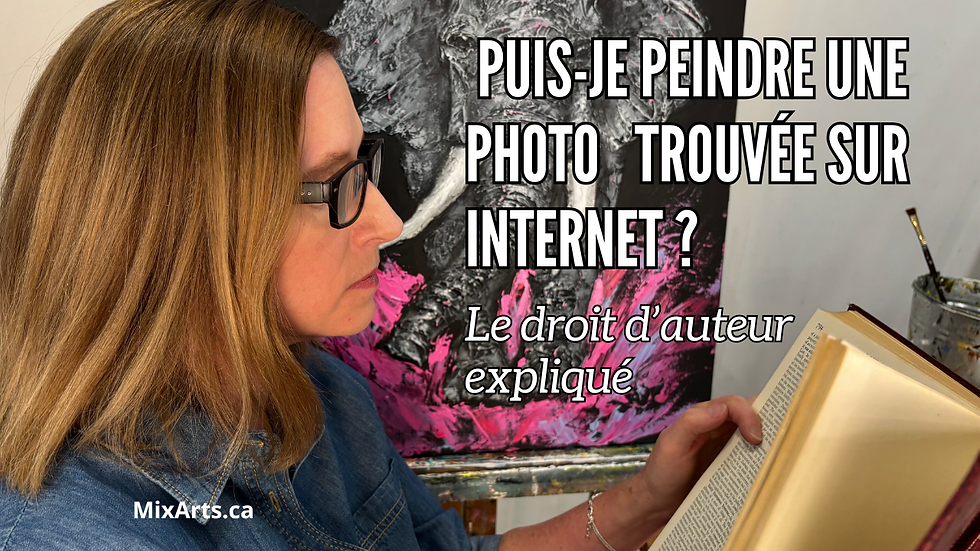What to paint when you start painting?
- Angel de cours de peinture Mixarts

- Aug 16, 2023
- 4 min read
Updated: May 13, 2024
Painting for beginners
If you are a beginner and wondering which subject to start with, I recommend the following subjects in this order whether in acrylic or oil.

1. Your love at first sight. Always!
A subject that makes you vibrate, whose colors you like. A subject that engages your emotions and that you can visualize on your wall.
When we like the subject, we are more patient, more persevering, we are ready to put in the effort and we are able to overcome our periods of discouragement. Because yes, there are going to be times when you won't get the results you want the first time and you'll have to make corrections... sometimes, several corrections.
As in all things, when you learn to paint, you make mistakes, you erase and you start over.
You become a good painter when you are able to correct your mistakes.
Whatever subject you choose to start with, you will always have to learn how to create your colors. You will also have to learn which brush to choose and how to use it to obtain the desired effect.
That's why I've created an online course to help you get to get to know your brushes well.
2. A landscape
Landscapes make excellent subjects for a beginner painter.
Why a landscape? Because you learn a lot by making landscapes.
You learn:
to mix your colors,
to master different brush strokes and how to apply paint,
a bit of perspective, where the light comes from,
to draw and paint
houses,
trees and shrubs,
reflections in water, rocks, etc.
...and the list goes on.
And the real reason is that a landscape is forgiving -
No one is going to know if your tree is too far to the left or to the right, except you.
If it's not exact or the same as the real thing, that's okay!
3. Flowers
Flowers are great for learning when you're just starting out.
I recommend it!
Painting flowers is both fun and challenging.
Painting flowers lets you learn and practice the fundamentals of acrylic and oil painting.
This is the perfect subject to learn:
observation,
the shapes (each petal is different),
shadows and light, values (very important),
gradients and fades,
color mixtures,
brush strokes.
In addition, it makes very beautiful canvases rich in colors.
4. Still life
When we think of still lifes, we think, among other things, of vases, fruit, a draped tablecloth and everyday objects that are arranged according to the rules of a good composition.
In addition to learning what is listed in the previous section, you also learn how to make reflections from vitreous surfaces, such as reflections on glass or porcelain.
Furthermore, making a still life can improve our drawing skills because it's always better to start with a good sketch. Our drawing skills improve with practice and doing still lifes is great exercise.
The following article can help you with your drawings: How to draw bigger
Here is a beginner canvas that you can make.
You can make this canvas with only 4 colors:
sap green,
cadmium yellow,
cadmium orange and
titanium white.
And using only 3 brushes:
an angled hog-hair brush,
a cat's tongue-shaped brush made of hog-hair and
a small fine brush for flower pistils.
Have fun!
Painting yellow flowers: yellow daylilies - Daylily - A study

Struggling to remember your color recipes?
Stop wasting time and paint trying to remember how to recreate a colour.
This notebook will save you time and prevent you from wasting paint
note the exact colors for each of your art works,
keep all your color recipes together, so you never forget,
keep all your inspirational images in one place for fast and easy reference.
This notebook helps you free your mind of details so you can concentrate on your creativity.
You can use these link depending on your location:
CANADA - CA : https://www.amazon.ca/dp/B0BS8ZZWHM
France - FR : https://www.amazon.fr/dp/B0BS8ZZWHM
USA - US : https://www.amazon.com/dp/B0BS8ZZWHM
Deutsch - DE : https://www.amazon.de/dp/B0BS8ZZWHM
Espagne - ES: https://www.amazon.es/dp/B0BS8ZZWHM
Italie - IT : https://www.amazon.it/dp/B0BS8ZZWHM
Nederlands - NL : https://www.amazon.nl/dp/B0BS8ZZWHM
日本語 - JA : https://www.amazon.co.jp/-/en/dp/B0BS8ZZWHM
Australie - AU: https://www.amazon.com.au/dp/B0BS8ZZWHM

How to enlarge all your drawings to scale without doing any calculations
How to guide to enlarge your drawings to reproduce a subject on a canvas with precision, without knowing how to draw and without having to take out your calculator.
Enlarge all your drawings effortlessly, even if you're not skilled in drawing.
Easily sketch photos onto canvas to scale, without the need for tedious calculations.
Subscribe to my channel to stay informed about new videos.
👉 YouTube
To learn more about our courses, visit:
Join us on the Facebook group and see what other artist like you are doing:
Discover articles about painting techniques on our blog:
To learn more about our online courses:





Comments